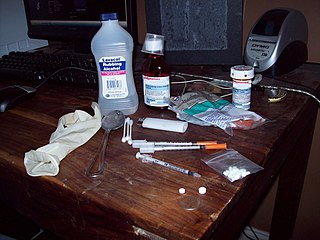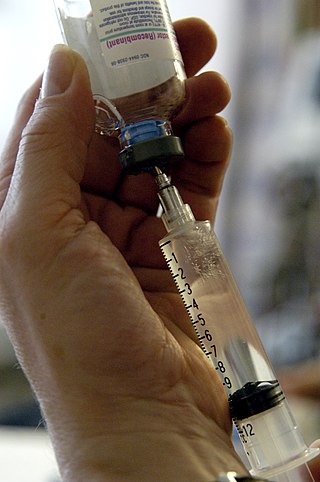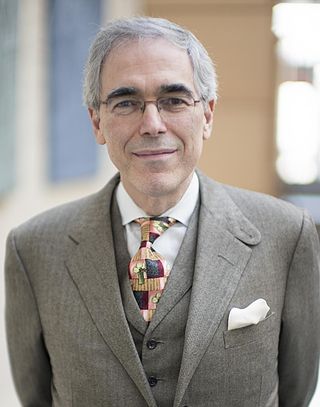
Harm reduction, or harm minimization, refers to a range of intentional practices and public health policies designed to lessen the negative social and/or physical consequences associated with various human behaviors, both legal and illegal. Harm reduction is used to decrease negative consequences of recreational drug use and sexual activity without requiring abstinence, recognizing that those unable or unwilling to stop can still make positive change to protect themselves and others.

A syringe is a simple reciprocating pump consisting of a plunger that fits tightly within a cylindrical tube called a barrel. The plunger can be linearly pulled and pushed along the inside of the tube, allowing the syringe to take in and expel liquid or gas through a discharge orifice at the front (open) end of the tube. The open end of the syringe may be fitted with a hypodermic needle, a nozzle or tubing to direct the flow into and out of the barrel. Syringes are frequently used in clinical medicine to administer injections, infuse intravenous therapy into the bloodstream, apply compounds such as glue or lubricant, and draw/measure liquids. There are also prefilled syringes.

A needle and syringe programme (NSP), also known as needle exchange program (NEP), is a social service that allows injecting drug users (IDUs) to obtain clean and unused hypodermic needles and associated paraphernalia at little or no cost. It is based on the philosophy of harm reduction that attempts to reduce the risk factors for blood-borne diseases such as HIV/AIDS and hepatitis.

A blood-borne disease is a disease that can be spread through contamination by blood and other body fluids. Blood can contain pathogens of various types, chief among which are microorganisms, like bacteria and parasites, and non-living infectious agents such as viruses. Three blood-borne pathogens in particular, all viruses, are cited as of primary concern to health workers by the CDC-NIOSH: HIV, hepatitis B (HVB), & hepatitis C (HVC).
Needle sharing is the practice of intravenous drug-users by which a needle or syringe is shared by multiple individuals to administer intravenous drugs such as heroin, steroids, and hormones. This is a primary vector for blood-borne diseases which can be transmitted through blood. People who inject drugs (PWID) are at an increased risk for Hepatitis C (HCV) and HIV due to needle sharing practices. From 1933 to 1943, malaria was spread between users in the New York City area by this method. Afterwards, the use of quinine as a cutting agent in drug mixes became more common. Harm reduction efforts including safe disposal of needles, supervised injection sites, and public education may help bring awareness on safer needle sharing practices.

An injection is the act of administering a liquid, especially a drug, into a person's body using a needle and a syringe. An injection is considered a form of parenteral drug administration; it does not involve absorption in the digestive tract. This allows the medication to be absorbed more rapidly and avoid the first pass effect. There are many types of injection, which are generally named after the body tissue the injection is administered into. This includes common injections such as subcutaneous, intramuscular, and intravenous injections, as well as less common injections such as intraperitoneal, intraosseous, intracardiac, intraarticular, and intracavernous injections.

A jet injector is a type of medical injecting syringe device used for a method of drug delivery known as jet injection. A narrow, high-pressure stream of liquid is made to penetrate the outermost layer of the skin to deliver medication to targeted underlying tissues of the epidermis or dermis, fat, or muscle.

A needlestick injury is the penetration of the skin by a hypodermic needle or other sharp object that has been in contact with blood, tissue or other body fluids before the exposure. Even though the acute physiological effects of a needlestick injury are generally negligible, these injuries can lead to transmission of blood-borne diseases, placing those exposed at increased risk of infection from disease-causing pathogens, such as the hepatitis B virus (HBV), hepatitis C virus (HCV), and human immunodeficiency virus (HIV). Among healthcare workers and laboratory personnel worldwide, more than 25 blood-borne virus infections have been reported to have been caused by needlestick injuries. In addition to needlestick injuries, transmission of these viruses can also occur as a result of contamination of the mucous membranes, such as those of the eyes, with blood or body fluids, but needlestick injuries make up more than 80% of all percutaneous exposure incidents in the United States. Various other occupations are also at increased risk of needlestick injury, including law enforcement, laborers, tattoo artists, food preparers, and agricultural workers.

A needle remover is a device used to physically remove a needle from a syringe. In developing countries, there is still a need for improvements in needle safety in hospital settings as most of the needle removal processes are done manually and under severe risk of hazard from needles puncturing skin risking infection. These countries cannot afford needles with individual safety devices attached, so needle-removers must be used to remove the needle from the syringe. This lowers possible pathogen spread by preventing the reuse of the syringes, reducing incidents of accidental needle-sticks, and facilitating syringe disposal.

Sharps waste is a form of biomedical waste composed of used "sharps", which includes any device or object used to puncture or lacerate the skin. Sharps waste is classified as biohazardous waste and must be carefully handled. Common medical materials treated as sharps waste are hypodermic needles, disposable scalpels and blades, contaminated glass and certain plastics, and guidewires used in surgery.

Jay Scott Walker is an American entrepreneur and chairman of Walker Digital, a privately held research and development lab focused on using digital networks to create new business systems. Walker is also curator of TEDMED since 2011, and a founder of Priceline.com and Synapse Group, Inc. In 2000, Forbes estimated his net worth at $1.6 billion. By October 2000, his estimated worth was down to $333 million. As of 2013, he is not on the Forbes list of the world's billionaires.

Drug injection is a method of introducing a drug into the bloodstream via a hollow hypodermic needle, which is pierced through the skin into the body. Intravenous therapy, a form of drug injection, is universally practiced in modernized medical care. As of 2004, there were 13.2 million people worldwide who self-administered injection drugs outside of medical supervision, of which 22% are from developed countries.
HONOReform – is a patient advocacy organization that seeks to promote adherence to injection safety guidelines and increase governmental oversight of outpatient medical facilities. In addition to promoting lessons learned from outbreaks of hepatitis C, the organization advocates for a more compassionate response to large scale medical disasters.
The Safepoint Trust is a UK registered charity, no. 1119073, that focuses on injection safety. Its aim is to educate people, worldwide, to ensure that the billions of medical injections given each year are given safely. The charity was founded by the inventor Marc Koska, OBE in 2006.
HIV prevention refers to practices that aim to prevent the spread of the human immunodeficiency virus (HIV). HIV prevention practices may be undertaken by individuals to protect their own health and the health of those in their community, or may be instituted by governments and community-based organizations as public health policies.

A safety syringe is a syringe with a built-in safety mechanism to reduce the risk of needlestick injuries to healthcare workers and others. The needle on a safety syringe can be detachable or permanently attached. On some models, a sheath is placed over the needle, whereas in others the needle retracts into the barrel. Safety needles serve the same functions as safety syringes, but the protective mechanism is a part of the needle rather than the syringe. Legislation requiring safety syringes or equivalents has been introduced in many nations since needlestick injuries and re-use prevention became the focus of governments and safety bodies.
Low-threshold treatment programs are harm reduction-based health care centers targeted towards people who use substances. "Low-threshold" programs are programs that make minimal demands on the patient, offering services without attempting to control their intake of drugs, and providing counselling only if requested. Low-threshold programs may be contrasted with "high-threshold" programs, which require the user to accept a certain level of control and which demand that the patient accept counselling and cease all drug use as a precondition of support.
Responsible drug use seeks to maximize the benefits and minimize the risks associated with psychoactive drug use. For illegal psychoactive drugs that are not diverted prescription controlled substances, some critics believe that illegal recreational drug use is inherently irresponsible, due to the unpredictable and unmonitored strength and purity of the drugs and the risks of addiction, infection, and other side effects.

An injector pen is a device used for injecting medication under the skin. First introduced in the 1980s, injector pens are designed to make injectable medication easier and more convenient to use, thus increasing patient adherence. The primary difference between injector pens and traditional vial and syringe administration is the easier use of an injector pen by people with low dexterity, poor vision, or who need portability to administer medicine on time. Injector pens also decrease the fear or adversity towards self-injection of medications, which increases the likelihood that a person takes the medication.

ApiJect Systems Corporation is an American company founded in 2018 by Marc Koska and based in Stamford, Connecticut that produces pre-filled single use plastic injectors. ApiJect works with pharmaceutical and biotech companies to fill their injectable drug products into single-dose prefilled injectors. The company claimed to have the capacity to manufacture pre-filled COVID-19 vaccine syringes by the end of 2020.














